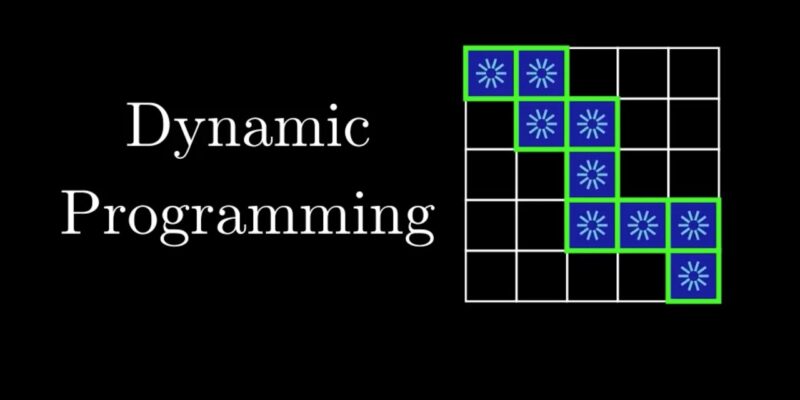
Dynamic programming is a useful way to solve hard algorithmic problems quickly in computer programming. It includes splitting a problem into smaller ones, solving each one separately, and then putting all of the answers together to get the best answer for the main problem. This guide will explain what is dynamic programming and how it works. It will also look at dynamic programming algorithms and give real-life cases to show how it can be used.
How Dynamic Programming Works
Dynamic programming works by breaking down a complex problem into simpler subproblems and finding optimal solutions to these subproblems. The solutions to subproblems are stored in a table or memoized for later use, reducing the need for repeated computations. Dynamic programming can be approached using two main strategies: the top-down approach and the bottom-up approach.
Dynamic programming starts by decomposing a complex problem into smaller, more manageable subproblems. These subproblems are then solved individually, optimizing their solutions using various techniques such as memoization or tabulation. The optimal solutions to subproblems are combined to find the overall optimal solution for the original problem.

What is Dynamic Programming Algorithms
Dynamic programming algorithms are designed to solve problems by breaking them down into smaller subproblems and finding optimal solutions to these subproblems. Here are some popular dynamic programming algorithms:
- Greedy Algorithms
Greedy algorithms are a class of dynamic programming algorithms that aim to find the optimal solution to a problem by making locally optimal choices at each step. They follow the principle of making the best choice at the current moment without considering the global consequences. While greedy algorithms can be efficient, they may not always lead to the globally optimal solution.
- Floyd-Warshall Algorithm
The Floyd-Warshall algorithm is a dynamic programming algorithm used to find the shortest paths in a graph with weighted edges. It computes the shortest path between all pairs of vertices in the graph, including both directed and undirected graphs. The Floyd-Warshall algorithm compares the potential paths between pairs of vertices and gradually optimizes the estimates to find the shortest distance between any two vertices in the graph.
- Bellman-Ford Algorithm
They use dynamic programming to find the shortest route from a source node to every other node in a weighted directed graph. This is called the Bellman-Ford method. The Bellman-Ford method is better than Dijkstra’s because it can correctly find the shortest path in graphs with negative edge weights. It works by adjusting the distances between the edges of the graph over and over again until the best answer is found.
Examples of Dynamic Programming
Dynamic programming can be applied to a wide range of problems to optimize their solutions. Here are a few examples:
- Identifying the Number of Ways to Cover a Distance
Think about a problem where you need to find all the possible ways to use a set of steps to go a certain distance. The subproblems in this problem overlap because the same subproblems come up more than once during the process. Using dynamic programming, you can save the answers to these subproblems and avoid doing the same calculations over and over. This makes the method much more efficient.
- Identifying the Optimal Strategy of a Game
Dynamic programming can be used to identify the optimal strategy of a game or gamified experience. For example, consider the “coins in a line” game, where two players take turns picking coins from either end of a line.
By using dynamic programming, you can compute the maximum value of coins taken by the first player, assuming that the second player plays optimally. This involves assigning values to each coin and considering the opponent’s choices. By observing the computed values, you can determine the optimal strategy for the game.
- Counting the Number of Possible Outcomes of a Die Roll
Suppose you want to count the number of possible outcomes when rolling a set of dice repeatedly to obtain a specific sum. This problem can be solved using dynamic programming by breaking it down into subproblems and computing their solutions iteratively. By utilizing an array to store the computed values, you can significantly reduce the computation time and obtain the desired result efficiently.
Advantages and Limitations of Dynamic Programming
Dynamic programming offers several advantages when solving complex algorithmic problems:
- Efficient solution to complex problems by breaking them down into smaller subproblems
- Optimal solutions obtained through the combination of subproblem solutions
- Reusability of computed solutions to avoid redundant calculations
- Improved performance compared to brute force or trial-and-error approaches
However, dynamic programming also has its limitations:
- Applicability limited to problems with overlapping subproblems and optimal substructures
- Increased memory usage compared to iterative approaches
- Complexity in identifying suitable subproblems and defining the optimal substructure
- Despite these limitations, dynamic programming remains a powerful technique for solving a wide range of optimization problems efficiently.
Also Read: What is Coding for Kids
In Closing
Now that you know what is dynamic programming, it’s certain that it’s a useful tool in computer programming because it lets you solve complicated mathematical problems quickly and correctly. Dynamic programming is a powerful way to solve problems because it breaks them down into smaller subproblems, stores the computed answers, and then combines them to get the best solution for the whole problem.
Dynamic programming is used in many real-life situations, such as to find the fastest path in a graph or the best way to play a game. Developers and programmers can solve difficult problems more quickly and elegantly if they understand the basic ideas and methods behind dynamic programming.

![How to Pause Location on Find My iPhone Without Them Knowing? [2024] 18 how to pause location on find my iphone](https://izood.net/wp-content/uploads/2024/10/How-to-Pause-Location-on-Find-My-iPhone-Without-Them-Knowing-400x300.png)


![How To Inspect Element on iPhone [4 Methods] 21 how to inspect element on iphone](https://izood.net/wp-content/uploads/2024/10/how-to-inspect-element-on-iphone-3-400x300.png)


